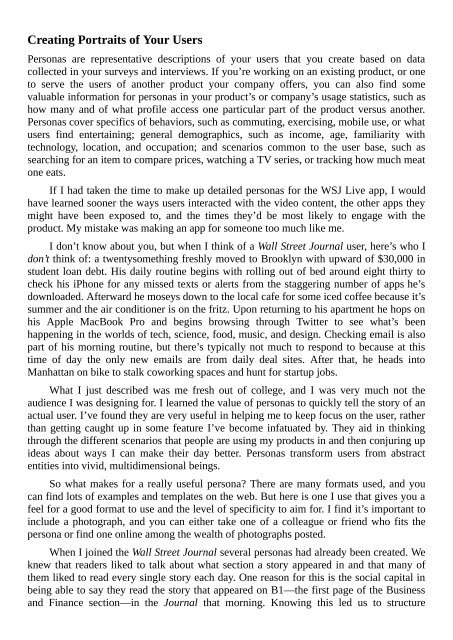Create successful ePaper yourself
Turn your PDF publications into a flip-book with our unique Google optimized e-Paper software.
Creating Portraits of Your <strong>User</strong>s<br />
Personas are representative descriptions of your users that you create based on data<br />
collected in your surveys and interviews. If you’re working on an existing product, or one<br />
to serve the users of another product your company offers, you can also find some<br />
valuable information for personas in your product’s or company’s usage statistics, such as<br />
how many and of what profile access one particular part of the product versus another.<br />
Personas cover specifics of behaviors, such as commuting, exercising, mobile use, or what<br />
users find entertaining; general demographics, such as income, age, familiarity with<br />
technology, location, and occupation; and scenarios common to the user base, such as<br />
searching for an item to compare prices, watching a TV series, or tracking how much meat<br />
one eats.<br />
If I had taken the time to make up detailed personas for the WSJ Live app, I would<br />
have learned sooner the ways users interacted with the video content, the other apps they<br />
might have been exposed to, and the times they’d be most likely to engage with the<br />
product. My mistake was making an app for someone too much like me.<br />
I don’t know about you, but when I think of a Wall Street Journal user, here’s who I<br />
don’t think of: a twentysomething freshly moved to Brooklyn with upward of $30,000 in<br />
student loan debt. His daily routine begins with rolling out of bed around eight thirty to<br />
check his iPhone for any missed texts or alerts from the staggering number of apps he’s<br />
downloaded. Afterward he moseys down to the local cafe for some iced coffee because it’s<br />
summer and the air conditioner is on the fritz. Upon returning to his apartment he hops on<br />
his Apple MacBook Pro and begins browsing through Twitter to see what’s been<br />
happening in the worlds of tech, science, food, music, and design. Checking email is also<br />
part of his morning routine, but there’s typically not much to respond to because at this<br />
time of day the only new emails are from daily deal sites. After that, he heads into<br />
Manhattan on bike to stalk coworking spaces and hunt for startup jobs.<br />
What I just described was me fresh out of college, and I was very much not the<br />
audience I was designing for. I learned the value of personas to quickly tell the story of an<br />
actual user. I’ve found they are very useful in helping me to keep focus on the user, rather<br />
than getting caught up in some feature I’ve become infatuated by. They aid in thinking<br />
through the different scenarios that people are using my products in and then conjuring up<br />
ideas about ways I can make their day better. Personas transform users from abstract<br />
entities into vivid, multidimensional beings.<br />
So what makes for a really useful persona? There are many formats used, and you<br />
can find lots of examples and templates on the web. But here is one I use that gives you a<br />
feel for a good format to use and the level of specificity to aim for. I find it’s important to<br />
include a photograph, and you can either take one of a colleague or friend who fits the<br />
persona or find one online among the wealth of photographs posted.<br />
When I joined the Wall Street Journal several personas had already been created. We<br />
knew that readers liked to talk about what section a story appeared in and that many of<br />
them liked to read every single story each day. One reason for this is the social capital in<br />
being able to say they read the story that appeared on B1—the first page of the Business<br />
and Finance section—in the Journal that morning. Knowing this led us to structure


